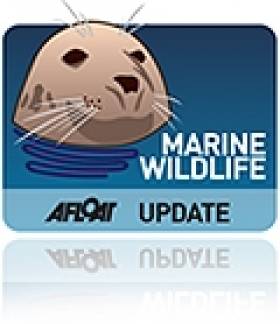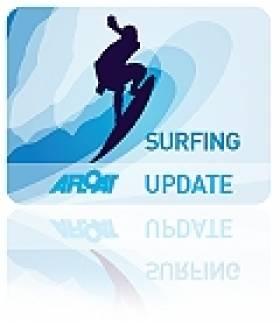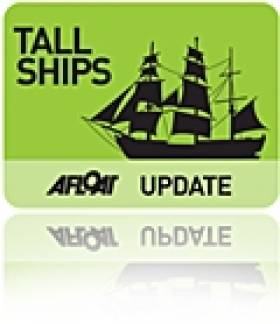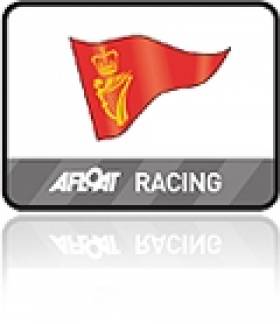Displaying items by tag: photos
Ireland's Sea Eagles In Photos From Birth To Death
#MarineWildlife - RTÉ News has posted some of Nigel Beers-Smith's wonderful photographs documenting Ireland's first native white-tailed eagles for over 100 years, one of which was found dead recently in shocking circumstances.
As The Irish Times reports, the male white-tailed or sea eagle was last seen on the eastern shore of Lough Derg in January before it was found dead from gunshot wounds in a remote part of Co Tipperary following a tip-off from the public.
The eagle was one of two reared by the nesting pair spotted on Bushy Island in Lough Derg nearly two years ago - marking the first time in over a century that white-tailed eagles had fledged in Ireland.
Minister for Arts, Hertiage and the Gaeltacht Jimmy Deenihan said he was "shocked" by the crime, which is a "significant blow" to the sea eagle reintroduction programme started in 2007.
“It is absolutely incomprehensible that someone would shoot one of these magnificent birds but even more shocking is that one of the first two Irish-bred eagles has been shot only seven months after leaving the nest," added reintroduction project manager Dr Allan Mee.
The project has already suffered from poisoning incidents, such as last year's discovery of two dead white-tailed eagles in Kerry and West Cork - both the result of consuming suspected tainted carrion.
The Irish Times has much more on the store HERE.
March's Big Waves Tease a Wild Summer of Surfing
#SURFING - Irish surf classifieds website Surfseekers.ie has compiled some stunning images from March's world-class surfing conditions.
From the biggest rollers in years off Mullaghmore Head in Co Sligo to the Cliffs of Moher and even as far south as Kerry, Ireland has seen some of its best surf in a long time - and things are certainly looking up for an exciting summer on the waves.
Stunning Photos of Kitesurfing in Dublin Bay
#KITESURFING - Photographer Luis Faustino has captured some stunning shots of Dublin kitesurfer Rob Clarke in action off Dollymount Strand.
"Dublin is quite windy, especially near the sea, in the bay," writes Faustino. "It's natural to see kitesurfers in many places and one of my favorite spots is Bull Island."
Find more of Luis Faustino's Dublin Bay kitesurfing photos HERE.
Bottlenose Dolphins Make New Home in Donegal
The Irish Independent reports that some 100 bottlenose dolphins have made a new home off the Donegal coast in the past week.
The pod of bottlenoses - a rare treat in Irish waters compared to the near ubiquitous common dolphin - has been spoted by boaters and wildlife enthusiasts in the inner Donegal Bay, between Rossnowlagh Beach and Doorin Head.
Patrick Lane of the Irish Whale and Dolphin Group said the bottlenose often swims closer to the shore than its more common counterparts, making it much easier for people on shore to catch a glimpse.
The Irish Independent has more on the story, including photos, HERE.
Waterford Tall Ships Parade of Sail Photos
Thousands bade farewell to the 45 tall ships departing Waterford this afternoon. Afloat Photographer Gary O'Mahony captured the scene. Scroll down for the photos.
Weather Gods at Play for October League Finale
Arriving at the Royal Cork Yacht Club yesterday for the final day of the O'Flynn Exhams Autumn League there wasn't a puff of wind to be felt writes Claire Bateman. The Club Burgee hung limply and the general consensus of competitors on the marina was that there wouldn't be any wind. However, lo and behold as the boats went out into the harbour wind was blowing from the south and spirits (not the Halloween Spooks) lifted immediately. PHOTO GALLERY HERE.
Race Officer David O'Brien in Admiral Paddy McGlade's Sabrone anchored off Whitegate and set a course a course for the Red Fleet out to the mouth of the harbour starting Class Two first and this was great as they were followed by the 1720s and in turn by the higher rated boats of Classes Zero and 1. This made for a great intermingling of the fleets in the harbour. Starting just after the top of the tide and with a southerly breeze this was a help to the boats on the beat as they tacked to and frow some favouring the western shore but the majority favouring the eastern shore. Conditions got a bit lumpy with the wind over tide and steeped up by a ground swell. There were a couple of showers but considering the summer like conditions that had been enjoyed for the series nobody was going to bother about this. After each shower cleared there was the most amazing light on the fleets and rainbows added more punch to the colour of the spinnakers.
In race 2 there was an incident on the line in Class 1 when there was a coming together of Mary O'Keeffe's Tux and Wan and Eric Waterman's Saxon Senator resulting in Senator's retiral. Also in the Red Fleet there were six boats disqualified for sailing the wrong way through the finish line – perhaps more reading of the Sailing Instructions required!!
Race Officer Richard Leonard in Pascal Healy's Capta Ventum anchored off Cuskinny to sail the Green Fleet on the laid courses. Richard, perfectionist that he is, complained bitterly that the wind had shifted some 20 degrees after the start and when sailing multi fleets particularly on a short course it would be extremely difficult to shift the marks. Nevertheless he got in two good races.
In Class 3 there was very keen competition between Ian Travers in Bandit and the Kenefick O'Brien favourite Tiger and they shared a first and second each on the day. However, Tiger triumphed overall by a winning margin of 2 points after 10 races. Newcomer to racing Fergus Coughlan in Whyte Knight had two wins on the day in Class 3 ECHO ensuring his overall andpopular win in this class.
IN Class 4 ECHO Michael Murphy in Shelly D created his own bit of sailing history when sailed his boat to victory in this class. He had sailed Shelly D in the October League for 31 consecutive years and received a a tremendous ovation for his efforts. However, in Class 4 IRC there was no stopping Alan Mulcahy in Sundancer from taking the overall prize with 7 wins and 2 seconds.
In White Sail 1 IRC Tom and Conor McNeice in Minx 111 had two thirds yesterday and this was enough to give them the overall win in the class. The Carroll Bros. In Chancer had two wins yesterday but ended up seond overall.
In White Sail 2 IRC Clive Doherty's Phaeton made a late challenge winning both races and this was enough for overall victory over Roy Hanan's Plumbat.
The prizegiving took place in a packed dining room after a very enjoyable meal. The prizes were magnificent, and were presented by Richard Neville, Managing Partner from the excellent sponsor O'Flynn Exhams Solicitors, aided by Admiral Paddy McGlade and Regatta Director, Rear Admiral Ronan Enright. Irene O'Donovan also a partner from the sponsor company, was present with her husband Pascal Healy who had provided the committee boat for the laid course and who were both on board for the series.
A most successful series was enjoyed by all and sundry and not forgotten in the acknowledgements were the club volunteers who had given freely of their time and effort to make the event the memorable Autumn League that it was.
New Asgard Wreck Photos Released
After the publication of the MCIB investigation report into the sinking of Asgard II the dive team lead by Eoin McGarry have released further photos of the wreck, showing different aspects of the boat including new shots of the hole in the hull.
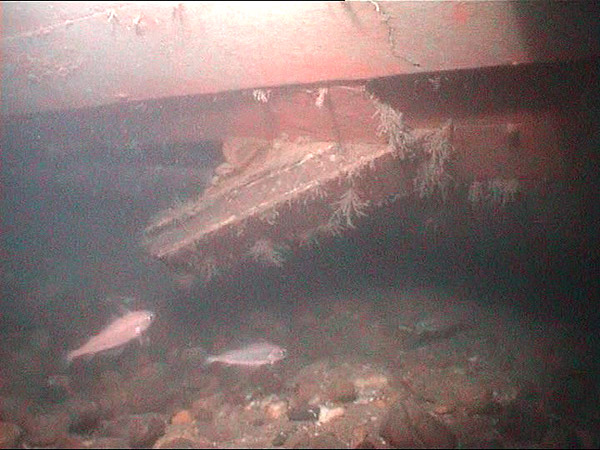
The "hole" in Asgard's Hull as it looked in July 2010 on the starboard bow, the long plank that was in the MCIB report pictures has fallen down and can no longer be seen. The view of the hole is harder to get now as the hull is listed to starboard and the seabed is silting up on the starboard bow and scouring on the port aft quarter and stern

The salvage pump used. It is located midships on the starboard side

A selection of nautical reading material still remarkably intact. The photo of the bookshelf is taken in the absence of the roof/deck of the navigation room. This is directly forward of the helm, the door out of the navigation room was just to the left of the books as you look at them


























